L2-L3- Antigens & Antibodies
1/83
There's no tags or description
Looks like no tags are added yet.
Name | Mastery | Learn | Test | Matching | Spaced |
|---|
No study sessions yet.
84 Terms
an epitope is the part of the antigen that can __________ with our immune system
interact
an ________ is the part of the antigen that can interact with our immune system
epitope
are all part of a protein antigenic
NO (ex: we wouldn’t make antibodies against self-protein polypeptide backbones)
can a single antigen have multiple epitopes on its surface
YES
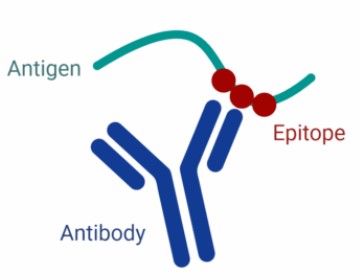
_______ epitopes are composed of amino acids that are contiguous in the primary sequence
linear
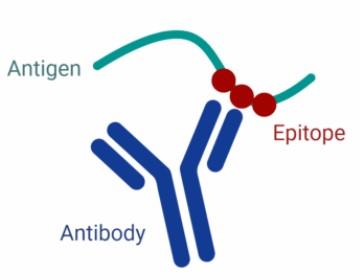
could an antibody recognize this epitope if it were denatured
YES (denatured= linearized, but its already straight so nothing would really change)
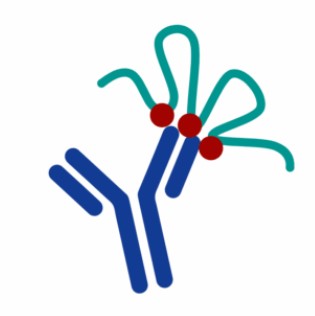
___________ epitopes are composed of amino acids that are NOT contiguous in the primary sequence
conformational
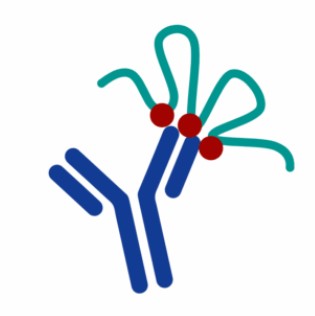
could an antibody recognize this epitope if it were denatured
NO (denatured= linearized, if we straightened this out the antibody might end up seeing a green nonantigenic part instead of the red)
in the context of immunizations, antigens on an infectious pathogen will be in the ______ state
native (tertiary or quaternary, immune system cant see stuff trapped inside)
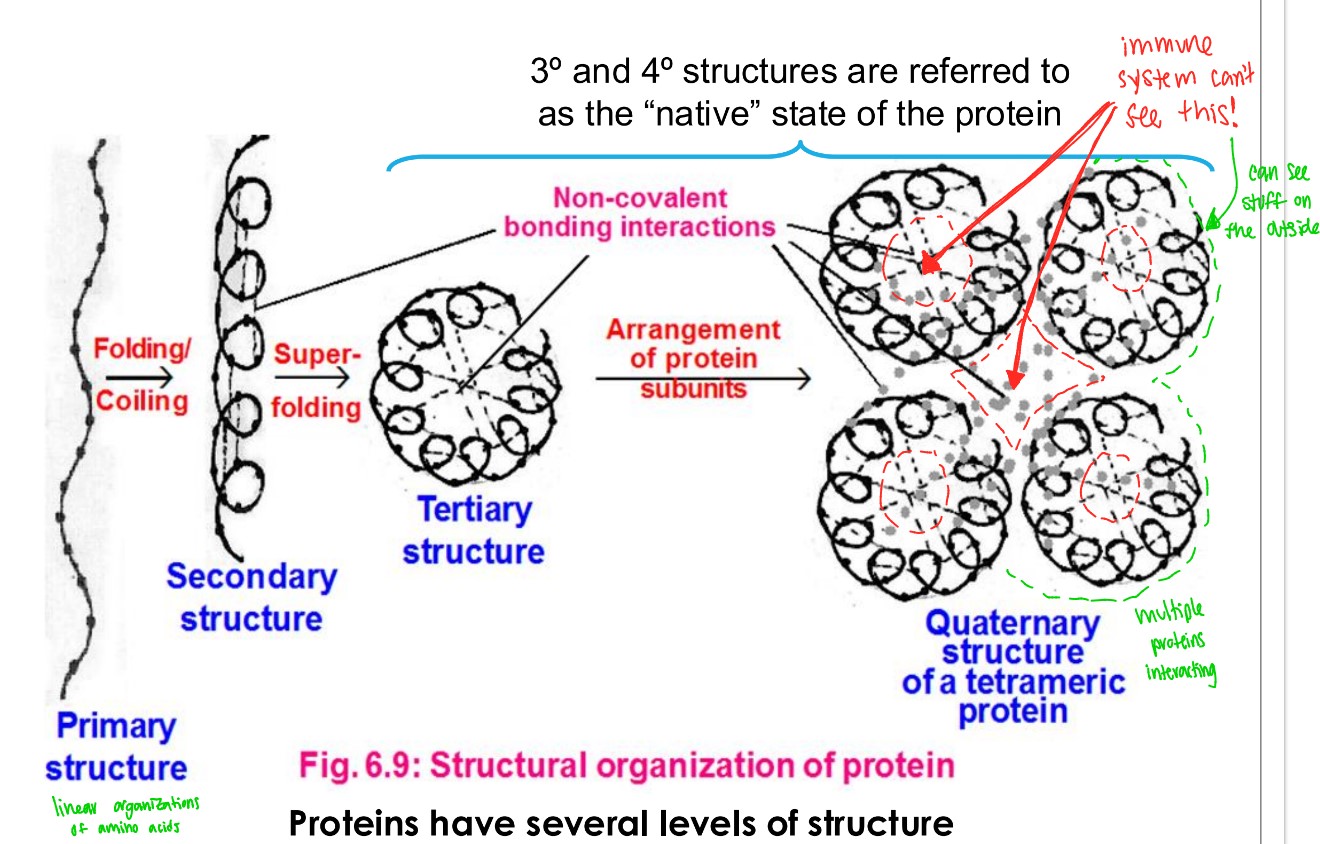
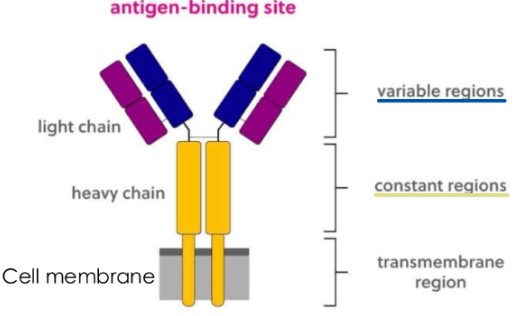
this is a ___ cell receptor
BCR (heavy and light chain)
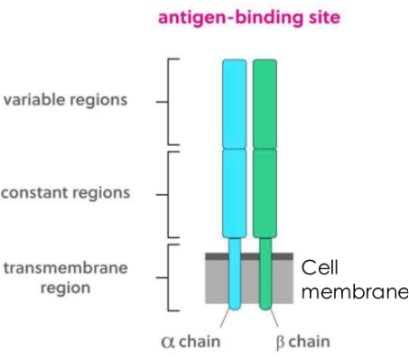
this is a ___ cell receptor
TCR (alpha and beta chain)
antigens with one epitope are called ________
haptens (only elicit immune response when attached to a larger carrier)
haptens are antigens with ______ epitope(s)
one (only elicit immune response when attached to a larger carrier)
haptens are antigens with only one epitope that can only be recognized when ______________
attached to a larger protein carrier
polysaccharides & homopolymers are examples of antigens with _______ epitopes of __________ specificities
many, same
___________ are examples of antigens with many epitopes of the same specificity
polysaccharides
proteins are examples of antigens with ________ epitopes of ________ specificities
many, different
_________ are examples of antigens with many epitopes of different specificities
proteins
before an antigen can be presented, it first must be ________
processed (broken down/digested)
every antibody has ___ identical antigen binding sites
two
every antibody has two _________ antigen binding sites
identical
can an antibody bind two different epitopes
NO (only 2 of the same epitope, could be on different antigens)
could an antibody bind two different antigens
YES, if they have the same epitope
affinity is the _________ of an Ag-epitope interaction
strength
_________ is the overall strength of binding between Ig-Ag considering all binding sites
avidity (affinity is just the strength of Ag-epitope)
immunogenicity is an immune response that can develop anti-_____ antibodies
drug (can reduce tx efficacy and cause ADRs)
_____antigens are certain bacterial toxins that produce overresponse by the immune system
superantigens
superantigens bind _______ to MHC receptors and T cells in __________ regions
directly, constant
do superantigen interactions rely on T cell specificity
NO (they can bind to any TCR)
__________ enhance immune response to antigen, but not to the ________ itself
adjuvants (often used in vaccines)
the hinge region of the antigen allows the ‘arms’ to rotate and spread, which is great for _________
opsonization
we want mAbs to have the ________ immunogenicity possible
lowest (want to kill the antigen, but don’t want some huge immune response)
glycosylation on antibodies is the attachment of _________ to protein
carbohydrates
____________ on antibodies is the attachment of carbohydrates to protein
glycosylation
is glycosylation, attachment of carbohydrates to protein, genetically encoded
NO (think, you have to eat carbs so your body doesnt just have those ready to go the way it has disulfides)
are disulfide linkages that hold the antibody chains together genetically coded
YES
disulfide linkages in antibodies hold the _________ together
chains
________________ in antibodies hold the chains together
disulfide linkages
Ig___ is the first antibody to be made against an infecting pathogen
IgM
_________ ___________ is changes in the DNA sequence of gene segments that encode the CDRs and selects for higher-affinity binders
affinity maturation
_________ _________ which selects antibodies that bind tighter to the pathogen
somatic hypermutation
in clonal selection, B cells with ______ affinity for the Ag will have better Ag binding
high
in clonal selection, B cells with low affinity for the Ag will NOT be selected to _________
reproduce
________________________ is required to produce IgG, IgA, and IgE from the original IgM
class switch recombination
in class switch recombination the heavy chain’s _______ region changes while its _______ region stays the same
constant, variable
naive B cells express Ig___ or Ig___
IgM or IgD
activation of naive B cell lets it become a _______ cell which can then secrete antibodies other than IgM or IgD
plasma
is class/isotype switching reversible
NO (once plasma cell secretes IgG, it can never start secreting IgM ever again)
_________ signaling is important for isotype switching specificity
cytokine
isotype switching occurs on the _______ region of the heavy chain
constant (constant, changes, class switch)
__________ ________ is a complex mix produced by a single animal host that is NOT reproducible from one host to another (easy to make, but bad for therapeutics)
polyclonal antiserum
polyclonal antiserum can recognize multiple _________ epitopes on the same antigen
different (mAbs all recognize the same epitope)
__________ _______ can recognize multiple different epitopes on the same antigen
polyclonal antiserum
hybridomas & monoclonal antibodies recognize ________ epitope(s)
same
_______ _________ all recognize the same exact epitope
monoclonal antibodies
which types of mAbs have the lowest immunogenicity (=best for therapy)
human
humanized mAbs are ~___& human, meaning they have pretty low immunogenicity
95 (almost as little immunogenicity as the fully human mAbs)
___________ mAbs are ~95% human
humanized
chimeric mAbs are ~___% human, meaning they have a moderate risk for immunogenicity
65
________ mAbs are ~65% human, meaning they have a moderate risk for immunogenicity
chimeric
bi-specific multi-Igs (migs) can bind two _______ antigens
different
____________ multi-Igs (migs) can bind two different antigens
bi-specific
bi-paratopic multi-Igs (migs) can bind two _________ epitope(s) on the same antigen
different
____________ multi-Igs (migs) can bind two different epitopes on the same antigen
bi-paratopic
bi-valent multi-Igs (migs) can bind two _________ epitope(s) on the same antigen
same
___________ multi-Igs (migs) can bind two of the same epitopes on the same antigen
bi-valent
multi-specific multi-Igs (migs) can bind 3 or more of _________ epitope(s) on the same antigen
different
____________ multi-Igs (migs) can bind 3 or more different epitopes on the same antigen
multi-specific
multi-specific multi-Igs (migs) can bind _____ different epitopes on the same antigen
3 or more
antibody drug-_________ deliver cytotoxic agents to cancer cells while sparing healthy cells
conjugates
biologics are derived from __________
living organisms
biosimilars emphasize __________ moreso than _______
similarity, safety (since the safety has already been studied)
____________ emphasize similarity moreso than safety
biosimilars
are biosimilars the same as generics
NO (since they are NOT exact copies of their reference products)
biosimilars are not the same as generics because they are NOT __________ as/of their reference products
exact copies (theyre just similar!)
interchangeables have met _______ requirements than biosimilars
more
___________ have met more requirements than biosimilars
interchangeables
____________ have additional requirements in order to mimic/match their reference
interchangeables
according to IL state law, can pharmacists substitute for interchangeables
YES but they must contact the patient & prescriber
in other states can interchangeables be substituted without having to contact the prescriber
YES (but not in IL)